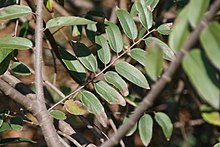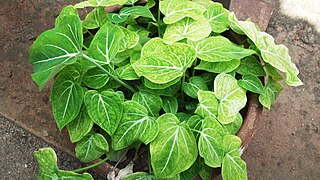
Caladium is a genus of flowering plants in the family Araceae. They are often known by the common name elephant ear, heart of Jesus, and angel wings. There are over 1000 named cultivars of Caladium bicolor from the original South American plant.

Lupinus angustifolius is a species of lupin known by many common names, including narrowleaf lupin, narrow-leaved lupin and blue lupin. It is native to Eurasia and northern Africa and naturalized in parts of Australia and North America. It has been cultivated for over 6000 years as a food crop for its edible legume seeds, as a fodder for livestock and for green manure.

The wildlife of Botswana refers to the flora and fauna of this country. Botswana is around 90% covered in savanna, varying from shrub savanna in the southwest in the dry areas to tree savanna consisting of trees and grass in the wetter areas. Even under the hot conditions of the Kalahari Desert, many species survive; in fact the country has more than 2500 species of plants and 650 species of trees. Vegetation and its wild fruits are also extremely important to rural populations living in the desert and are the principal source of food, fuel and medicine for many inhabitants.

The hairy-footed gerbil is a species of rodent found in Angola, Botswana, Mozambique, Namibia, South Africa, and Zimbabwe. Its natural habitats are dry savanna, temperate shrubland, hot deserts, sandy shores, and urban areas. All members of this genus have hair on the soles of their feet, hence the name. They prefer sandy soil or sandy alluvium with grass, scrub or light woodland cover.

The white-bellied sunbird, also known as the white-breasted sunbird, is a species of bird in the family Nectariniidae. It is found in Angola, Botswana, Democratic Republic of the Congo, Eswatini, Malawi, Mozambique, Namibia, South Africa, Tanzania, Zambia, and Zimbabwe.
Phyllonorycter grewiella is a moth of the family Gracillariidae. It is known from South Africa, Botswana, Kenya, Namibia and coastal Yemen. The habitat consists of the coastal savannahs of southern and East Africa and the forests belonging to the Zanzibar-Inhambane floristic region.

Anaphe reticulata, commonly known as the reticulate bagnest or reticulate bagnet, is a moth of the family Notodontidae which is native to savannah in sub-Saharan Africa. It was described by Francis Walker in 1855. It has been recorded from Angola, Eritrea, Ivory Coast, Malawi, Mozambique and South Africa. In southern Africa it is described as common and widespread. Anaphe panda is similar in appearance and habits.
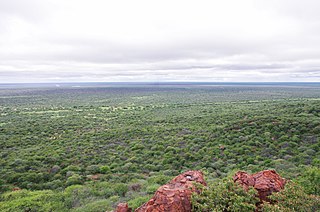
Woody plant encroachment is a natural phenomenon characterised by the increase in density of woody plants, bushes and shrubs, at the expense of the herbaceous layer, grasses and forbs. It predominantly occurs in grasslands, savannas and woodlands and can cause biome shifts from open grasslands and savannas to closed woodlands. The term bush encroachment refers to the expansion of native plants and not the spread of alien invasive species. It is thus defined by plant density, not species. Bush encroachment is often considered an ecological regime shift and can be a symptom of land degradation. The phenomenon is observed across different ecosystems and with different characteristics and intensities globally.
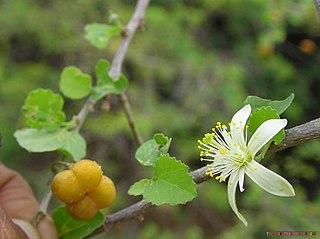
Grewia tenax, called the phalsa cherry, white crossberry, raisin bush, gangara, gangu, or kanger, is a species of flowering plant in the family Malvaceae. It is native to Africa, from the Sahara to Tanzania and parts of southern Africa, the Arabian Peninsula, and on to the Indian Subcontinent. The ripe fruit is edible and is consumed by local peoples either fresh, dried, or powered in drinks.

Indigofera hirsuta, the hairy indigo or rough hairy indigo, is a species of flowering plant in the family Fabaceae. It is native to nearly all the world's tropics; South America, Africa, Madagascar, the Indian Subcontinent, southern China, southeast Asia, Malesia, Papuasia and Australia, and has been introduced to the Caribbean, the southeast United States, Mexico and Central America. It is used as a green manure and, to a minor extent, for forage.
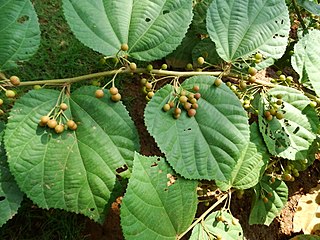
Grewia optiva, the bhimal, is a species of flowering plant in the family Malvaceae, native to the Indian Subcontinent.
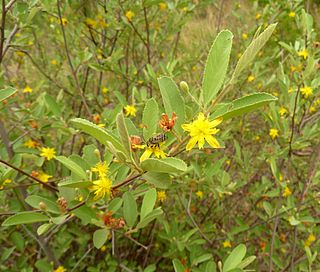
Grewia flava, the brandy bush, wild currant, velvet raisin, or raisin tree, is a species of flowering plant in the family Malvaceae, native to southern Africa. A common shrub species, it is spreading into grasslands due to human rangeland management practices, and increasing rainfall. The berries are sweet and edible, but have little flesh and so are typically collected to ferment into alcoholic beverages. The desert truffle Kalaharituber pfeilii is often found in association with its roots.

Grewia flavescens, called rough-leaved raisin, sandpaper raisin, and donkey berry, is a species of flowering plant in the family Malvaceae, native to sub‑Saharan Africa, Yemen, Saudi Arabia, and India. It is considered to be an underutilized crop, both for its fruit and its use for livestock forage. Caterpillars of Anaphe reticulata have been found to feed on the foliage.
Grewia kakothamnos is a species of flowering plant in the family Malvaceae, found from southern Ethiopia to Tanzania. Its flowers are white to pale lilac, and its two or four-lobed fruit are orange when ripe, and edible in a famine situation. Grewia kakothamnos is particularly enjoyed as a forage by domestic goats, which will even eat the dead fallen leaves during the dry season.

Indigofera spicata, the creeping indigo or trailing indigo, is a species of flowering plant in the family Fabaceae. It is native to Sub‑Saharan Africa, Madagascar, Mauritius, Réunion, and Yemen, and has been introduced to the southeastern United States, various Caribbean islands, Brazil and other locations in Latin America, various Pacific islands, and New South Wales and Queensland in Australia. It was considered to be a promising forage plant, and then shown to be toxic to nearly all livestock, but it is possible that the experiments were conducted on the similar Indigofera hendecaphylla, leading to some confusion.

Grewia hexamita, the giant raisin, is a species of flowering plant in the family Malvaceae, native to Mozambique and adjoining countries. It is a large tree for a Grewia, reaching 5 m (16 ft). It is the most preferred woody plant of African savanna elephants, who browse on it in all seasons, unlike even other species of Grewia.

Sorghum × almum, the Columbus grass, is a hybrid species of flowering plant in the family Poaceae. Its parents are Sorghum bicolor × S. halepense (Johnsongrass). Sorghum × almum is one of the most valuable livestock forage and fodder crops during summer in semi-arid and sub-humid areas worldwide. It is considered a noxious weed in several US and Australian states.
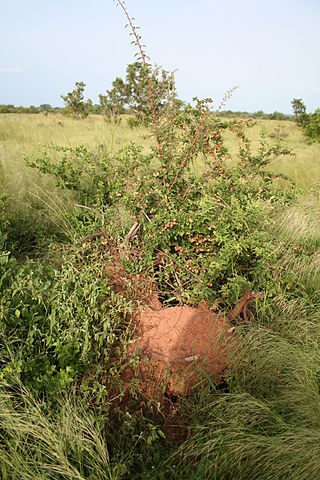
Combretum aculeatum is a species of flowering plant in the bushwillow genus Combretum, family Combretaceae. It is native to the Sahelian and Sudanian savannas and adjacent forest–savanna mosaic in Africa and Saudi Arabia, and has been introduced to Myanmar. High in protein, it is greatly relished as a browse by wild and domesticated mammalian herbivores, except elephants.

Grewia rogersii, the waterberg raisin is a species of plant in the family Malvaceae. It is generally considered a rare species as defined by the International Union for the Conservation of Nature and Natural Resources, but it can be abundant locally.

